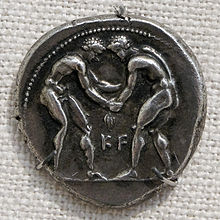Ancient Greek wrestling

Wrestlers on a silver tetradrachm of Aspendos, Pamphilia (400–374 BC)
|
|
| Also known as | Roman Wrestling |
|---|---|
| Focus | wrestling |
| Country of origin | Ancient Greece |
| Olympic sport | Yes |
Greek wrestling (Greek: πάλη, pálē), also known as Ancient Greek wrestling and Palé, was the most popular organized sport in Ancient Greece. A point was scored when one player touched the ground with his back, hip or shoulder, or conceding defeat due to a submission-hold or was forced out of the wrestling-area. Three points had to be scored to win the match.
One particularly important position in this form of wrestling was one where one of the contestants was lying on his belly with the other on his back trying to strangle him. The athlete on the bottom would try to grasp an arm of the one on top and turn him over onto his back while the athlete on top would try to complete the choke without being rolled.
Wrestling was the first competition to be added to the Olympic Games that was not a footrace. It was added in 708 B.C. (Miller, 46). The competitions were held in elimination-tournament style until one wrestler was crowned the victor. The wrestling area was one square plethron or stremma. This event was also part of the pentathlon. Wrestling was regarded as the best expression of strength out of all of the competitions and was represented in Greek mythology by Heracles.
Milo of Croton was one of the most famous wrestlers from this ancient time period. At one set of games, no one challenged him, but as he walked to the skamma he slipped and fell and was harassed by the crowd as they claimed he shouldn't be crowned because he fell. He contested that he should be crowned because he had only fallen once, two short of the required at least three times (Martin, 50). Leontiskos of Messene was also a noted champion. He was not known for his good wrestling skills, but for his superior finger bending skills. He was able to bend right up to the point of disqualification and won two championships with this technique (Martin, 50).
These are the rules of the ancient sport Palé:
...
Wikipedia
